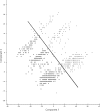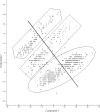Considerations when using discriminant function analysis of antimicrobial resistance profiles to identify sources of fecal contamination of surface water in Michigan
- PMID: 17337537
- PMCID: PMC1892867
- DOI: 10.1128/AEM.02376-06
Considerations when using discriminant function analysis of antimicrobial resistance profiles to identify sources of fecal contamination of surface water in Michigan
Abstract
The goals of this study were to (i) identify issues that affect the ability of discriminant function analysis (DA) of antimicrobial resistance profiles to differentiate sources of fecal contamination, (ii) test the accuracy of DA from a known-source library of fecal Escherichia coli isolates with isolates from environmental samples, and (iii) apply this DA to classify E. coli from surface water. A repeated cross-sectional study was used to collect fecal and environmental samples from Michigan livestock, wild geese, and surface water for bacterial isolation, identification, and antimicrobial susceptibility testing using disk diffusion for 12 agents chosen for their importance in treating E. coli infections or for their use as animal feed additives. Nonparametric DA was used to classify E. coli by source species individually and by groups according to antimicrobial exposure. A modified backwards model-building approach was applied to create the best decision rules for isolate differentiation with the smallest number of antimicrobial agents. Decision rules were generated from fecal isolates and applied to environmental isolates to determine the effectiveness of DA for identifying sources of contamination. Principal component analysis was applied to describe differences in resistance patterns between species groups. The average rate of correct classification by DA was improved by reducing the numbers of species classifications and antimicrobial agents. DA was able to correctly classify environmental isolates when fewer than four classifications were used. Water sample isolates were classified by livestock type. An evaluation of the performance of DA must take into consideration relative contributions of random chance and the true discriminatory power of the decision rules.
Figures






Similar articles
-
Patterns of antimicrobial resistance observed in Escherichia coli isolates obtained from domestic- and wild-animal fecal samples, human septage, and surface water.Appl Environ Microbiol. 2005 Mar;71(3):1394-404. doi: 10.1128/AEM.71.3.1394-1404.2005. Appl Environ Microbiol. 2005. PMID: 15746342 Free PMC article.
-
Differentiation of faecal Escherichia coli from humans and animals by multiple antibiotic resistance analysis.Lett Appl Microbiol. 2006 Jan;42(1):71-7. doi: 10.1111/j.1472-765X.2005.01803.x. Lett Appl Microbiol. 2006. PMID: 16411923
-
Novel application of a statistical technique, Random Forests, in a bacterial source tracking study.Water Res. 2010 Jul;44(14):4067-76. doi: 10.1016/j.watres.2010.05.019. Epub 2010 May 31. Water Res. 2010. PMID: 20566209
-
Characterisation of Escherichia coli O157 strains from humans, cattle and pigs in the North-West Province, South Africa.Int J Food Microbiol. 2008 Dec 10;128(2):181-8. doi: 10.1016/j.ijfoodmicro.2008.08.011. Epub 2008 Aug 28. Int J Food Microbiol. 2008. PMID: 18848733 Review.
-
Human health hazards from antimicrobial-resistant Escherichia coli of animal origin.Clin Infect Dis. 2009 Apr 1;48(7):916-21. doi: 10.1086/597292. Clin Infect Dis. 2009. PMID: 19231979 Review.
Cited by
-
Genomic analysis of phylogroup D Escherichia coli strains using novel de-novo reference-based guided assembly.Sci Data. 2023 Sep 1;10(1):573. doi: 10.1038/s41597-023-02444-0. Sci Data. 2023. PMID: 37658065 Free PMC article.
-
A New Investigation to Discriminate Sexes in Alive Nile Tilapia (Oreochromis niloticus) Using Cyp19a1a and Dmrt1 Gene Expression in Tail Fin Tissues.Mar Biotechnol (NY). 2024 Oct;26(5):943-950. doi: 10.1007/s10126-024-10340-w. Epub 2024 Jun 28. Mar Biotechnol (NY). 2024. PMID: 38940867 Free PMC article.
-
Worldwide Phylogenetic Group Patterns of Escherichia coli from Commensal Human and Wastewater Treatment Plant Isolates.Front Microbiol. 2017 Dec 21;8:2512. doi: 10.3389/fmicb.2017.02512. eCollection 2017. Front Microbiol. 2017. PMID: 29312213 Free PMC article.
-
Prevalence and Antimicrobial Resistance of Escherichia coli Isolated from Various Meat Types in the Tamale Metropolis of Ghana.Int J Food Sci. 2020 Nov 12;2020:8877196. doi: 10.1155/2020/8877196. eCollection 2020. Int J Food Sci. 2020. PMID: 33274191 Free PMC article.
-
Antibiotic susceptibility profile of bacteria isolated from natural sources of water from rural areas of East sikkim.Indian J Community Med. 2014 Jul;39(3):156-60. doi: 10.4103/0970-0218.137152. Indian J Community Med. 2014. PMID: 25136156 Free PMC article.
References
-
- American Public Health Association. 1998. Standard methods for examination of water and waste water, 20th ed. American Public Health Association, Inc., Washington, DC.
-
- Babini, G. S., M. Yuan, L. M. C. Hall, and D. M. Livermore. 2003. Variable susceptibility to piperacillin/tazobactam amongst Klebsiella spp. with extended-spectrum β-lactamases. J. Antimicrob. Chemother. 51:605-612. - PubMed
-
- Beharav, A., and E. Nevo. 2003. Predictive validity of discriminant analysis for genetic data. Genetica 119:259-267. - PubMed
Publication types
MeSH terms
Substances
LinkOut - more resources
Full Text Sources
Medical

